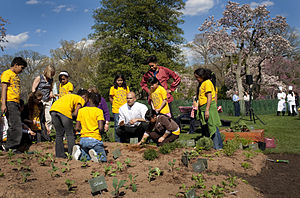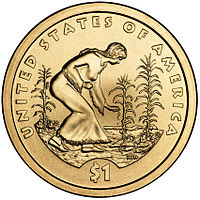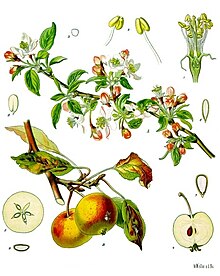The Read
I just finished reading ‘American Grown’ by Michelle Obama and it is a fascinating account of the garden and landscape evolution at the White House. From the very first vegetable garden installed by John Adams, our second president, the book mentions a variety of plantings and gardens until it ended up being a hodgepodge of styles and designs in the 1930’s. At that point, President Franklin Roosevelt asked the renowned Frederick Law Olmstead Jr., a landscape artist who designed Central Park in New York City, to draw up a master plan. Olmstead created the vistas and features that we are familiar with today – notably the South Lawn with rolling lawns and groupings of trees. The landscape that he created is what basically remains today.

The book also includes how-to tips for starting your own kitchen garden, involving children in the process, and several accounts of how schools across the county are changing their students eating habits and getting them to be more active. Recipes from the White House Executive Chef Cris Comerford using the produce were my favorite part as well as dozens of black and white historic photos.

The 1100 square foot L-shaped vegetable kitchen garden is on the White House south lawn in raised beds with slate plant tags, and has a path winding through for easy access. Michelle Obama wanted the location of the garden to be easily seen from outside the White House gate because she wanted it to be the people’s garden, just as the White House is the “people’s house”. Peas, spinach, lettuce, broccoli, raspberries, blueberries, carrots, tomatoes, figs, mushrooms, and peppers are just a few of the over 55 varieties of vegetable and herb crops that are planted and harvested for use in the White House kitchen. Mushrooms were even grown on logs that were placed under trees! All produce is used for family meals and state dinners and is also donated to Miriam’s Kitchen, a local soup kitchen. The garden is grown organically with edible and companion flowers planted along the path and numerous herbs, and has produced thousands of pounds of produce.
The garden was started in 2009, early in the Obama’s term, and was instrumental in the First Lady starting her ‘Let’s Move!’ campaign which focused on healthy eating and exercise. The First Lady along with White House horticulturist Dale Haney and the enthusiastic help of 23 5th graders from Bancroft Elementary in D.C., plant the garden every spring and takes care of the garden as well as learning about eating healthy.

White House Chef Sam Kass, who personally harvests many of the herbs and vegetables for the meals he cooks, was inspired after a visit to Monticello to include an area devoted to Thomas Jefferson where the vegetable favorite’s of the third president are planted. Monticello sells a special seed collection that Jefferson grew at his home that includes Tennis Ball Lettuce, Prickly Seeded Spinach, Red Calico Lima Beans, Sesame, Globe Artichokes, and Early Jersey Wakefield Cabbage. Offered by Monticello’s online store at http://www.monticellocatalog.org/, you can order this seed mixture yourself for $18.

Three Sisters
Another area of the garden is called ‘The Three Sisters’ which is corn, beans, and squash planted together. The Native Americans used this planting scheme extensively and called the three plants ‘The Three Sisters’ because they grow and thrive together. The beans grow up the corn plants for support and the squash acts as a living mulch and shades the base of the plantings.
Three Sisters  shown on the reverse of the Native American 2009 dollar coin.
shown on the reverse of the Native American 2009 dollar coin.
In June of 2011, Cherokee White Eagle corn, Rattlesnake pole beans, and Seminole squash seeds donated by the National Museum of the American Indian were planted in the White House garden preceded by a special ceremony and blessing by Native Americans.

How – To
There is a great section on basic how-to knowledge to jump-start your own vegetable garden, from making compost up of ‘browns and greens’ to container gardening. I thought the most important point was to grow what you like to eat. The importance of sunlight is stressed with the statement ‘sun equals success’ which is a factor that so many people forget. Americans have a long tradition of vegetable gardening and it is time to reconnect with that heritage. The book is a great starter for any newbie.

Cooking Class
Thinking that kids are more willing to try healthy food choices if they are involved in growing their own food, Michelle Obama started the vegetable garden at the right time for America. Many people are concerned with organic food choices, eating a better diet and buying locally. The Bancroft Elementary School not only plants and harvests the vegetables, but also prepares and tastes the food with the White House Chef. Lucky kids!
I tried two of the recipes – the mac and cheese with cauliflower, and the white bean salad, and got thumbs up from my family. Go to http://www.npr.org/2012/06/12/154854113/first-lady-fights-obesity-with-moves-and-good-food?ft=1&f= to see more recipes that sound delicious.
First Year Lessons
I really was interested in Michelle Obama’s essay on lessons learned in the first season. One problem was that they grew perfectly round cantaloupes that were totally tasteless! I have had that problem also and stopped growing them. Another situation was the blackberry bushes took up too much room for the few pieces of fruit harvested. To combat this problem, I train them on a trellis. They also found that even with netting, birds ate every blueberry. I chalk that up to the plants were immature and weren’t old enough to be loaded with berries so that the birds could eat their fill.

Cutworms became a problem in the White House garden and the gardeners combated that by enclosing new plants in bottomless paper cups, an old organic gardener trick. Another lesson learned was to mulch with a thin layer of straw to keep the soil moist and the weeds down. These were pretty basic common situations that many gardeners face and the White House gardeners learned through experience. This book is an inspiration for people to start their own garden and the knowledge is very basic but helpful.
The garden has become a very popular tour for school kids and if you are a teacher you can tour the kitchen garden on a first-come, first-served basis by going to http://www.whitehouse.gov/ and fill out an application. The tour is free which includes the garden only, not the house, and is held every Tuesday and Thursday at 11:30 AM, weather permitting.
Honey and Bees at the White House
Adjacent to the kitchen garden, is the first ever beehive at the White House that is tended by White House carpenter Charlie Brandts. This part was my favorite because it really showed how ignorant people are about honeybees. Bees will only sting unless provoked and are more interested in finding nectar than bothering someone. In all the years that I have had hives at my house (10), I have never had anyone stung except for me! And that was trying to remove the honey!
The President initially was “less than enthusiastic” especially since the hive would be near the basketball court and he was concerned about the dog and the girls being stung. The hive was set up high to keep the entrance well above kids who visit the garden and the flight path was placed so it would be in the opposite direction of the basketball court. Also, the hive was strapped securely so that winds from the presidential helicopter wouldn’t tip it over during landings!
The beehive has over 70,000 bees and honey is harvested from the hives and used in the White House kitchen. Go to http://www.youtube.com/watch?v=gNaLV8KwTr8 and watch the video ‘The Secret Life of White House Bees’ for a fascinating account of setting up the hive and harvesting the honey. To harvest the honey, Charlie Brandts smokes the bees to calm them and then blows the bees off the frames with a leaf blower!
One interesting story about the White House bees is that there was an apple tree on the South Lawn for 25 years that had never produced an apple. Once the bees were installed, the apple tree produced baskets of delicious apples. That just proves how important bees are to pollination.
Blossoms, fruit, and foliage of an apple tree.
The honey is extracted right in the White House kitchen which really impressed me. When I extract honey, every surface around gets sticky and covered with bees and I don’t do it in the kitchen! Just the one hive at the White House has produced 140 pounds the first year, 183 pounds the second, and 225 pounds the third – an impressive total! Honey is donated to Miriam’s Kitchen, used in the White House kitchen, and given as gifts to dignitaries and heads of state. A pound of honey was used to brew the first White House honey ale! I wonder how it tasted?

Michelle Obama is trend setting with her vegetable garden initiative and lots of families are taking note and starting their own vegetable garden. Even the Queen of England copied what our First Lady did and has started her own palace vegetable garden with school children. Now is the time to dust off those kitchen garden plans and start sowing!
Related articles
- Michelle Obama’s ‘American Grown,’ and More (nytimes.com)
- ‘American Grown,’ Michelle Obama: review (sfgate.com)
- Michelle Obama’s new book features gardening lore, tips and tidbits (knoxnews.com)
- Michelle Obama’s ‘American Grown’ is out (mnn.com)
- With her new gardening book, Michelle Obama stays away from politics (odetocapitalism.com)
- Recipes from the White House Kitchen Garden (telegraph.co.uk)
- Michelle Obama: my White House Kitchen Garden (telegraph.co.uk)
- Michelle Obama’s Book ‘American Garden’: A Radical Act (mamapop.com)
- White House garden inspires urban gardening trend (kdvr.com)
- The First Lady Cultivates ‘American Grown’ Gardening : NPR (drweb.typepad.com)
- Michelle Obama Writes ‘American Grown’ (nytimes.com)
- Michelle Obama’s Recipe For Corn Soup With Summer Vegetables (chicago.cbslocal.com)



Another problem with veggie garden are BIRDS, at least that’s my experience. I will recommend something that I have been using, is a hawk bird scarer. It’s eco friendly, no poison, no plastic, no collateral damage, nothing! It is a devise that looks like a hawk that I set up once and scares many birds from eating my crops. you can get more info @hawkbirdscarer.com
I have used these fake birds in the past. My only problem is that once the surrounding birds get used to it, they ignore it.